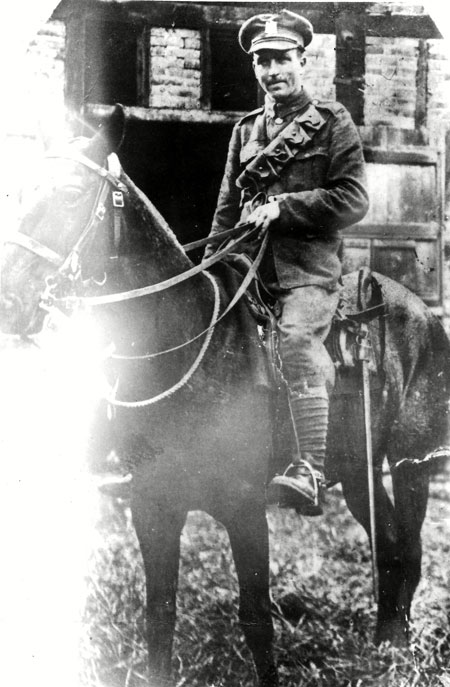Private William John Nixon

William John Nixon was born (as William James McKeown) on 12 May 1894 at 14 Brooke Street, Dungannon, County Tyrone, the second child of factory stockkeeper William James McKeown and his wife Mina (née Craig). His father had died six months before he was born. On 31 July 1896 his mother married house painter Alexander Nixon. At the time of the 1911 Census William was living at 31 Perry Street, Dungannon, with his mother, step-father, sister, three half-siblings and another relative, and working as a house painter. Soon after, it appears, he adopted the name Nixon.
Nixon enlisted in the 6th (Inniskilling) Dragoons Service Squadron between 2 and 9 November 1914 (No. UD/111).
The Strabane Weekly News of 14 November reported that:
A further detachment of recruits from Dungannon U.V.F. left Dungannon to join the Inniskilling Dragoons – namely, Messrs. William McKeown, Harry Hamilton, Fred Noble, and John Meenagh (Miltown). Altogether 225 members of the Dungannon U.V.F. Battalion have now volunteered for active service, as compared with only 19 Nationalists from the same district.
On 6 October 1915 he embarked for France with his squadron, which was then serving as divisional cavalry to the 36th (Ulster) Division.
In June 1916 the Inniskilling squadron joined with C and F Squadrons of the North Irish Horse to form the 2nd North Irish Horse Regiment, serving as corps cavalry to X Corps. In August-September 1917 the Regiment was disbanded with its men to be transferred to the infantry.
Nixon was one of 70 men given the job of conducting the regiment's horses to Egypt, to be handed over for use by mounted units there. They embarked from Marseilles on board HMT Bohemian on 25 August. After a month at Alexandria they returned to France, via Italy. On 5 October 1917 they arrived at the 36th (Ulster) Division Infantry Base Depot at Harfleur for infantry training, and after just a few days were posted to the 9th (Service) Battalion, Royal Irish Fusiliers – which had been renamed the 9th (North Irish Horse) Battalion – joining it in the field at Ruyaulcourt on 12 October. Nixon was issued regimental number 41612 and was posted to B Company.
He probably saw action with the battalion at the Battle of Cambrai in November and December 1917.
Nixon was one of the many of the 9th (NIH) Battalion listed as missing following the fighting retreat from St Quentin from 21 to 28 March 1918 during the German spring offensive. It was later learned that he had been wounded. He was later able to rejoin his battalion.
He was wounded again between August and early October during the Advance to Victory offensive.
Nixon was demobilised and transferred to Class Z, Army Reserve, on 3 March 1919. He returned to his birth name McKeown after the war.


In later life at a Remembrance Day parade.
I am grateful to Dermot McKeown for providing these images of his grandfather.
This page last updated 3 September 2023.
